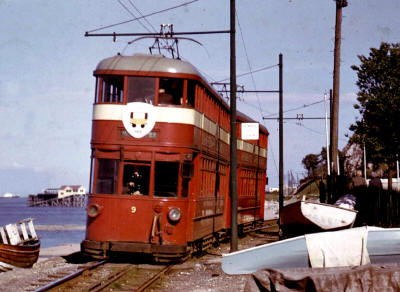From the BBC – Wales Southwest: The Swansea and Mumbles Railway, the first public railway that ended as LRT!
A little history lesson today: The Swansea and Mumbles Railway, the first public railway which operated fromAi??Ai??1807 to 1960.Ai??Ai??Starting fromAi??Ai??horse drawnAi??Ai??converted rail carriages, the Swansea and Mumbles Railway ended up as a light rail/interurban line, using rather large double-deck electric trams.
 Ai??Ai??
Ai??Ai??
Early Days of Mumbles Railway
Ai??Ai??
From a four-wheeled dandy attracting international visitors for a “novelty” ride, to scenes when its passengers narrowly escaped being bombed – the history of the railway is intriguing and varied.
Even today the Mumbles Railway is held in remarkable affection by local people as historian Carol Powell now recounts in a series of features about its history and development.
Ai??Ai??Steam trains and bank holiday daytrippers
On 25 March 1807, the very same day that the British Parliament passed a Bill to outlaw the transatlantic trade in slaves, Swansea took its place in history with the inauguration of the world’s first passenger railway.
The carriage, initially a four-wheeled horse-drawn dandy, wound its way slowly from the Brewery Bank adjacent to the Swansea Canal in Swansea, around the wide sweep of Swansea Bay to its destination at Castle Hill (near the present-day Clements Quarry) at the tiny isolated fishing village of Oystermouth.
The line had originally been built in 1804 to transport limestone from the quarries of Mumbles to Swansea and thence to the markets beyond.
In March 1807, Benjamin French, one of its shareholders paid Ai??A?20 to the Tramroad Company, so that he could run a wagon on the line for a year to convey passengers. By 1813, the booklet ‘A Description of Swansea and its Environs’ noted that the fare was two shillings, (which would have been only affordable by the select few).
Some years later, ‘The New Swansea Guide’ of 1823 quoted one shilling – perhaps because of anticipated competition from the new toll road, which was due to open alongside in 1826.
The line continued for a while, but the horse-drawn buses made it economically unviable to operate the railway and the service had been withdrawn before 1830.
However, by the 1860s, the line was once more in business. On 17 August 1877, steam trains were introduced, but as the ownership of the line was in dispute, a situation was created whereby horse-drawn and steam trains competed on the same track at the same time, until the horses were phased out in 1896
In the late 1890s, the line from Blackpill towards Oystermouth was transferred from the roadside to the seaward side of the houses and was extended from Oystermouth across Horsepool, past Southend to reach the newly-constructed pier, the route that many of us remember.
Years leading up to the Great War
For many years, the Horsepool had been a natural harbour for the skiff owners to lay up and repair their boats.
This area was filled in when the new railway extension was built across it and instead a large wooden breakwater, which came to be known locally as ‘The Piles’ was constructed on the shore opposite the Antelope Public House-a move not very popular with the oyster- and fishermen.
At first, a fairground which included a figure-of-eight ride was set up on part of the infill, on what became known as the Ballast Bank, but today the area is occupied by the tennis courts, bowling green, Cornwall and Devon Places and Promenade Terrace.
The years leading up to the Great War were undoubtedly the heyday of the line with immense numbers of holiday-makers and daytrippers visiting the village, a fact amply illustrated when on a fine August Bank Holiday in 1913, some 48,000 passengers arrived on the train to enjoy a visit!
On 2 March 1929, a gleaming new fleet of red electric trains superseded the steam locomotives and these operated even throughout the war and on through the 150th anniversary of the line in 1954, until January 1960, when for many reasons, the powers-that-be decided that the days of the world-famous Mumbles Train were over.
http://www.bbc.co.uk/wales/southwest/sites/swansea/pages/mumbles_trainanniv.shtml
Ai??

Ai??



